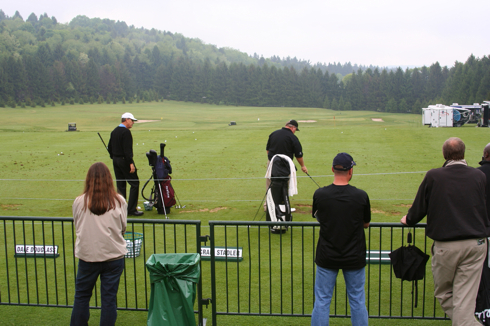 Slow play is at an all-time high. It’s pretty tough for a guy who has a family, work, a lawn to mow, kids to raise, and a host of other responsibilities to get away for a round of golf. When you do play it’s no fun to wait on every tee and fairway to hit the next shot. Five- and six- hour rounds are a bummer and all too common.
Slow play is at an all-time high. It’s pretty tough for a guy who has a family, work, a lawn to mow, kids to raise, and a host of other responsibilities to get away for a round of golf. When you do play it’s no fun to wait on every tee and fairway to hit the next shot. Five- and six- hour rounds are a bummer and all too common.
Take a peek at some of the causes of slow play and see if you can’t turn your next slow round into a faster one by eliminating a few.
Number Five: You are not Tiger Woods
 Let’s face it: average amateurs can hardly hit the ball out of their own shadow. The rumors of regular 300-yard drives at the local municipal are greatly exaggerated. Most guys aren’t Tiger Woods. In fact there is only one Tiger.
Let’s face it: average amateurs can hardly hit the ball out of their own shadow. The rumors of regular 300-yard drives at the local municipal are greatly exaggerated. Most guys aren’t Tiger Woods. In fact there is only one Tiger.
Measuring the drives of an average amateur might make him turn red with embarrassment. The misinformation (read: fish story) thrown around by hackers also makes it difficult for them to improve. To get better you have to take a wide-eyed look at your game and exaggerating your abilities doesn’t help you or the pace of play.
One of the best ways to slow a course to a standstill is to wait while a group clears the green on a short 320-yard par four. It is more likely that you hit the ball 240 than it is 320. Keep in mind that the longest hitters on Tour hit the ball around 300 yards per drive. These are the longest hitters in the world. Hello! Short knockers on the PGA Tour hit it between 255 and 270 yards.
The net result is that players often under-club themselves and have to take extra shots as a result. We should know our abilities and hit the ball to our real distance. On the odd chance that you exceed your average pat yourself on the back for the fluke and apologize to the group ahead. Again, such times will be incredibly rare.
Number Four: Feeling Chatty?
 Perhaps you’re like me: One of the best parts of playing the game is hanging out with your buddies. You enjoy the game, the weather, and the camaraderie. This is a good thing – just know how to handle it. Golf is one of the most enjoyable sports for just this reason. You’re getting some exercise while enjoying the company of friends or acquaintances.
Perhaps you’re like me: One of the best parts of playing the game is hanging out with your buddies. You enjoy the game, the weather, and the camaraderie. This is a good thing – just know how to handle it. Golf is one of the most enjoyable sports for just this reason. You’re getting some exercise while enjoying the company of friends or acquaintances.
Learn when and when not to talk. Chat with your buddies while you’re riding in the cart to the next shot or the next tee. Chat after both you and your partner have hit your shots. When you see that your playing partner wants to go through his pre-shot routine without the help of your verbal skills do him a favor: stop talking.
To ensure an efficient round it is as important to manage your mouth as it is to manage your game.
Number Three: Practice on the Range
Practice tees are for practice and golf courses are for playing golf. What is more frustrating to watch than a guy practice and fuss over the ball only to chunk it ten yards?

I find that a practice swing is beneficial from time to time I make a real effort not to take more than one or two practice swings prior to a shot. Normally I will not take a full-speed practice swing on any shot.
Too many practice swings will wear you out and are not beneficial in making better swings. Train yourself to quickly visualize, stand up to the ball, and swing away.
Quick Tip: nobody wants to watch six practice swings and a chili dip. It’s far more humiliating than one practice swing and a chili dip.
Number Two: Rough and Ready!
 Your buddy is about to swing and begins to go through his pre-shot routine. What should you be doing? Collecting information for your next shot. Know what club you need, what the conditions are like, what line you need to hit your putt on, and be in the moment before it’s your turn to play. Start this process as soon as you’ve hit your last shot.
Your buddy is about to swing and begins to go through his pre-shot routine. What should you be doing? Collecting information for your next shot. Know what club you need, what the conditions are like, what line you need to hit your putt on, and be in the moment before it’s your turn to play. Start this process as soon as you’ve hit your last shot.
This is toward the top of the list for obvious reasons. If more players would be clubbed and ready to go when it is their turn to hit, minutes could be saved on the golf course. This doesn’t require any more effort just more initiative. Start earlier.
Unless you are a low single-digit handicap you should have a general idea how far you hit each club and make your best guess on club selection. You can get pretty good at eyeballing yardage markers if you do this regularly. Take your best guess, be ready, and swing away!
Number One: Ignorance
 The sad truth is that the majority of golfers don’t know how slow they really are. Many players are unknowingly part of the problem when they should be a part of the cure.
The sad truth is that the majority of golfers don’t know how slow they really are. Many players are unknowingly part of the problem when they should be a part of the cure.
Chit chat, extra practice swings, over-reading greens, leaving carts in the wrong place, dilly-dallying at the turn, and a host of other inefficient playing habits slow many courses to a crawl and it is unnecessary.
It doesn’t take much to slow a course down. Erik’s Slow Play Calculations proved that seconds, multiplied over 18-holes can turn into hours lost or saved.
Make up your mind now to be a part of the solution. Determine that the next time you’re out for a round it’ll be a quick and yet enjoyable round. Trying practicing the things you’ve read here and you’ll likely enjoy yourself more and play better to boot.
Photo Credits: © Unknown, © Erik J. Barzeski/The Sand Trap.
This is a longer version of what a replied to earlier. You see people fuss over a shot only to chilly dip it and then stand there and take 3 or more practice swings like “How did that happen?” (Get over it you suck!) Most players want to think they are better than they are and that sells clubs. The reality is they miss the pleasure of the game by worrying if they are impressing anyone. I recently played a round with an elderly couple and had a great time. He was extremely slow but I tended the flags and picked up his wedges to keep the pace going.
He asked me a one hole how much difference the BIG drivers make and I offerered to let him hit it. He declined and used his 1972 driver even after I insisted. I got the couples address after the round and as a treat I am sending him a new driver for Christmas (Because I enjoyed thier company). Golf is a great game and I thank my Dad for teaching me this pleasure. Remember pace is also respect, it is hard to teach that value in this world these days.
The lost ball rule is a good culprit although it should only be a problem in unfamiliar surroundings.
Spend 5 minutes searching and then marching back to the tee (or last shot) is pretty much a hole’s worth of time blown then and there. Provisionals will help a lot but sometimes we just get caught out.
Mind you, I can’t think of a rule change that wouldn’t be exploitable in some way.
I use a modified version of lost ball rule.
First, I try to restrict my time searching for lost balls to just a couple of minutes per hole, instead of 5 minutes per ball. When you put a lot of them into the woods, it quickly becomes apparent that you can’t spend 5 minutes looking for each ball and still maintain some semblance of a decent pace of play.
Second, when I declare my ball lost, I go to the spot where I think the ball entered the woods and hit my next shot from there, a la the water hazard rule. Obviously, I can’t do this if I were to play strictly by the rules, but I don’t play in tournaments or maintain a handicap. I suppose I could hit a provisional ball, but then I’d have to search the woods for two lost balls. 🙂
Can some one articulate the average time on the PGA tour, now remember they rarely play in foursomes.
I think amatures should be given the same time as a pro, whether they are as good or not should not matter. After all the rules of golf apply equally to a pro as they do to an amature player.
I do think everyone should complete their rounds in the 4 hours and 20 minutes allotted by the rules , but so should the pro and if they don’t stroke penalties should apply and not some financial penalty over the course of 10 rounds.
Perhaps I am wrong and PGA pros do actually play a round in regulation time. So perhaps the PGA can publish average round times of their two somes or three somes, which should be less than 4 hours and 20 minutes. If not, I think the same amount of time should be available to amature players.
While I agree that slow play is a problem on the PGA Tour, there’s a big difference between paying to play versus being paid to play. If I was playing for $1.2M, I’d take a little more time, too.